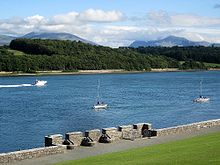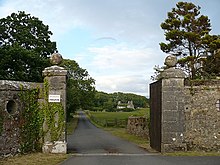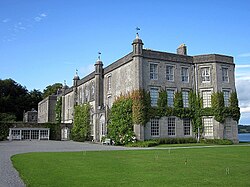|
Plas Newydd (Anglesey)
Plas Newydd (Welsh for 'new hall') is a country house set in gardens, parkland and surrounding woodland on the north bank of the Menai Strait, in Llanddaniel Fab, near Llanfairpwllgwyngyll, Anglesey, Wales. The current building has its origins in 1470, and evolved over the centuries to become one of Anglesey's principal residences. Owned successively by Griffiths, Baylys and Pagets, it became the country seat of the Marquesses of Anglesey, and the core of a large agricultural estate. The house and grounds, with views over the strait and Snowdonia, are open to the public, having been owned by the National Trust since 1976. HistoryFrom its earliest known residence in 1470, Plas Newydd passed by inheritance and marriage through more than 400 years of a family's increasing concentration of wealth, titles and estates until the ascendency of Henry Paget, 5th Marquess of Anglesey, whose profligate spending almost bankrupted the estate. Henry Paget, 7th Marquess of Anglesey presented it to the National Trust in 1976 so that the house and grounds could be opened to the public.[3][4] Origins The house site was first occupied in the 13th century and was known as Llwyn-y-Moel. By 1470 it belonged to the Griffith family, who also owned Penrhyn Castle near Bangor.[4] Before the 15th century residence was built, the proprietor of the land also owned several more tenements in the surrounding area on Anglesey. It was first recorded as being owned by Meredydd Ddu in the 1300s. After being passed from father to son until the 1470s,[5] the family of Gwilym ap Griffith acquired substantial Anglesey holdings from his marriage to Morfydd, daughter of Goronwy ap Tudur of Penmynydd, including Llwyn-y-Moel.[4] Robert Griffith built the earliest parts of the current house in the early 16th century, creating a hall-house.[2] Bagnall and Bayly familiesIn 1533 Ellen Griffith married Nicholas Bagenal and they took possession of what was still known as Llwyn-y-Moel, and the property was sold or mortgaged to Henry Bagnall about 1575. Their granddaughter Ann married Lewis Bayly, Bishop of Bangor. It was Lewis Bayly who made the first major additions to the house and was the first to call it Plas Newydd (Welsh: New Hall).[4][5] The Baylys lived in Plas Newydd, along with other estates, particularly in Ireland, and Lewis's grandson Edward Bayly acquired an [baronetcy] in 1730 when he was styled Baronet of Plas Newydd in the County of Anglesey and Mount Bagenall in the County of Down. Lewis's great-grandson Sir Nicholas Bayly, 2nd Baronet married Caroline Paget in 1737 and became Lord Lieutenant of Anglesey.[5] In 1761, a position his family would fill for the next 100 years. Their son, Henry, was to be the beneficiary of substantial inheritances from both sides of the family.[citation needed] Bayly to PagetBorn in 1744 as Henry Bayly, he succeeded, through his mother,[5] to the title and estates of the Barony of Paget in 1769,[6] on the death of Henry Paget, 8th Baron Paget and Earl of Uxbridge, a distant cousin on his mother's side. As 9th Baron Paget, Henry Bayly took possession of the Beaudesert estates in Staffordshire, and changed his surname to Paget. (Unlike the Barony, the Earldom could not pass through the female line, so the Earldom of Uxbridge became extinct.) In 1782 his father died, which added "3rd Baronet" to his titles, and Plas Newydd to his estates. He also took over as Lord Lieutenant of Anglesey. In 1784 he was created Earl of Uxbridge as a second creation of that Earldom. Plas Newydd had been extended in the middle of the 18th century, with an octagonal tower at the south-east corner, but under Henry's care there were substantial additions and rebuilding throughout the estate, especially with the appointment of James Wyatt and Joseph Potter as architects.[citation needed] Earls of Uxbridge to Marquesses of AngleseyPlas Newydd itself was greatly altered in the 18th century by James Wyatt, who refaced it, blended the towers into the building front, and made it into substantially the building that stands today. He also had constructed the large Gothic style stable block which is now part of the Conway Centre, and various lodges and gateways were also constructed. In 1812 Henry died, and the estate passed to his son Henry William Paget, who became the 2nd Earl of Uxbridge. Henry William had raised a regiment of volunteers in the 1790s, was commissioned into the Army in 1795, and distinguished himself in numerous engagements and campaigns across Europe. By 1802 he was a major-general, and in 1815 was appointed cavalry commander, leading a spectacular charge of the British heavy cavalry at the Battle of Waterloo. In recognition of his heroism he was created the first Marquess of Anglesey, although he lost a leg from one of the last cannon shots of the day.[7] The following year the 27 metre column was raised in his honour, sited to the north of Plas Newydd.[8] At the end of the 19th century Henry Paget, 5th Marquess of Anglesey inherited the family seat, which he renamed Anglesey Castle. Renowned for his lavish spending and flamboyant lifestyle, he converted the family chapel inside the house into a performance space called the Gaiety Theatre. Plays were put on regularly, with "the Dancing Marquess" often taking the lead role himself.[9] The 5th Marquess's extravagant spending drained the family fortune, and after his death in 1905, Charles Paget, 6th Marquess of Anglesey began to sell off assets to help restore the solvency of the family. The family also sold off their main home at Beaudesert and their London house, and moved into Plas Newydd permanently.[10] The 6th Marquess made the final big changes to the house by removing the crenellations from the roof, disposing of the theatre, knocking three servants' rooms together to make the dining room and covering over a courtyard to provide a roof for the servants. In the 1930s the artist Rex Whistler was a regular visitor to Plas Newydd. He painted numerous portraits of Lady Caroline Paget, and in 1936-38 painted the largest canvas painting in the UK.[11] It is a trompe-l'œil seascape painting that fills a whole wall of the dining room with an imagined scene of Italianate churches, castles, Snowdonian mountains and a complete harbour wall, with tricks of perspective that mean the scenes appear to change when seen from different parts of the room.[12]  The house has been owned by the National Trust since 1976.[13] HMS ConwayIn 1949 the training ship HMS Conway was moored in the Menai Strait near Plas Newydd. The ship was supported from the small dock in the grounds of the estate. The ship was wrecked after running aground in 1953, and the school built temporary facilities in the grounds near the current reception centre. These were used for teaching and housing the senior cadets. The younger cadets were accommodated in the eastern wing of the house. The former stables building was used for teacher accommodation, classrooms and a laboratory. These arrangements continued until 1963 when the entire school moved into a new purpose-built building in the grounds of the estate. The school was closed in 1974 but the buildings and the grounds were subsequently acquired by Cheshire County Council. It was renamed the Conway Centre and is now managed by a stand-alone organisation, Quality Learning Partners,[14] with the support of Cheshire West and Chester Council, and is used as an outdoor adventure centre.[15] Points of interest The house contains Rex Whistler’s largest painting, measuring 58 by 12 feet (17.7 by 3.7 m). The 7th Marquess of Anglesey retained rooms at the house until his death in July 2013.[16] Lady Rose McLaren grew up at the house along with the 7th Marquess - her brother. The 8th Marquess no longer lives at the house.[citation needed] At the house there is also a military museum which contains campaign relics belonging to the 1st Marquess of Anglesey, mementos of the Battle of Waterloo and the Anglesey Leg.[17] Parkland and gardensThe house is set within an outstanding park, landscaped at the turn of the 18th and 19th centuries.[2] The design included input from Humphry Repton, and his trademark Red Book of before and after landscape views is still extant. With its extensive waterside site, superb location, and views of the Menai Strait and Snowdonia, it is the only Anglesey site to be classed as Grade I in the Cadw/ICOMOS Register of Parks and Gardens of Special Historic Interest in Wales.[18] It is within the Anglesey Area of Outstanding Natural Beauty and is within an Environmentally sensitive area.[2] In January 2010, the grounds became the first part of North Wales to be included in Google Street View, thanks to a scheme to include National Trust properties by using the Google Trike which scanned the paths at Plas Newydd in August 2009, where vehicular access is limited.[19][20] Scheduled monumentsThere are two prehistoric scheduled monuments on the site. The two monuments formed a single entry in the Ancient Monuments Protection Act 1882, and so, along with two other Welsh monuments, were among the first to receive legal protection.[21]  Plas Newydd Burial Chambers are two adjoining stone chambers of a Neolithic burial cairn or cromlech. They stand on private lawns in front of the house.[22] Bryn-yr-Hen-Bobl Burial Chamber ("Hill of the old people") is a substantial mound with a stone chamber, to the south of the parkland. Bones were found here in 1754. It was excavated by Wilfrid James Hemp in 1929–35, and Neolithic pottery appeared to lie under and in front of the mound, suggesting a settlement predating its use as a burial site. The chamber was given a doorway following the dig, but is not accessible to the public. It is visible from the southern edge of 'Garden Wood'.[23] Listed buildings on Plas Newydd EstateIn addition to the Grade I listed main house, Plas Newydd had a large estate covering 3,848 hectares (9,510 acres) including outlying properties. The main estate lands stretched from the Grand Lodge in the north to Llanedwen in the south, taking in further listed buildings and structures in the estate grounds.[24]  North of the House
 East of the House
Grade II listed retaining wall built between 1796 and 1819, probably designed by Wyatt and Potter for Lord Uxbridge. Although always an ornamental feature, it sets a distinctly military tone to the sea wall. The five cannons ('trunnion' carronades) date from around 1830–45, and are from Fort Belan, at the southeastern tip of the Menai. Thomas John Wynn, 5th Baron Newborough gave them as a wedding present to Lord and Lady Anglesey in 1948.[33]
West of the House
 Llanedwen, south of the HouseParts of the settlement of Llanedwen, including the church, lie within the parkland of Plas Newydd. Home Farm, Plas Llanedwen and the Church have two entrance gateways and lodge buildings, off the road that forms the estate's south-western boundary.
Heat sourceThe National Trust has invested £600,000 in a marine source heat pump to provide heating for the house.[47][48][49] At 300 kilowatts, the pump is the biggest in Britain.[48] Its oil-fired boiler made the mansion the most polluting[47] and biggest oil consumer[48] of the National Trust's properties;[47] the renovation is expected to save around £40,000 a year in operating costs.[47] Plas Newydd is one of five properties in a pilot experiment;[47][48] if they succeed, the National Trust will invest in 43 more renewable energy plans.[47][48] The pilot programme includes: biomass in Croft Castle in Herefordshire, a woodchip boiler in Ickworth in Suffolk, and hydroelectric projects in Hafod y Porth near Craflwyn in Snowdonia,[50] and at Stickle Ghyll in the Lake District.[47][48] GallerySee also
References
External linksWikimedia Commons has media related to Plas Newydd, Anglesey.
|
||||||||||||||||||||||||||||||||||||||||||
Portal di Ensiklopedia Dunia








